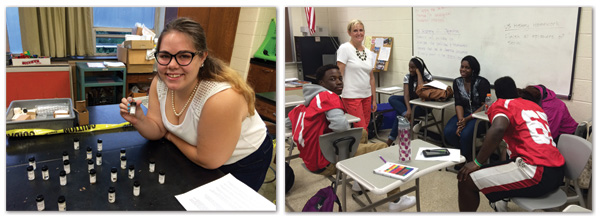A School-Wide Study of "Serial"

Student Abbie Fuller (left) examines larvae during a science class forensics study.
Right: Lauren Boyle’s sociology class debates whether anti-Muslim prejudice impacted Syed’s conviction.
Photos by Robin Brenner
On Friday, September 11, 2015, students at Waltham (MA) Senior High School were greeted with familiar music: the opening strains of Serial, the smash-hit podcast.
Over the summer, instead of reading, the students had listened to the first season of the podcast, investigating the 1999 murder of high school student Hae Min Lee and the ensuing conviction of ex-boyfriend Adnan Syed for that crime. Friday was the day to tackle Serial from all angles, with students and teachers using writing, science, math, art, and dance to explore the case’s many questions.
In the past, school librarian Kendall Boninti and English teacher Emilie Perna used One School, One Book for the summer reading program that they cochair, and selected one title for the entire school to read. But participation varied, Boninti notes.
“We chose a nonfiction book the first year, and some students loved it and some didn’t like it at all,” she says. At the same time, an increasing number of students opted for the audiobook version. Ten percent of ninth graders listened to Ernest Cline’s Ready Player One (Random, 2011) rather than read it, Perna says. “We wanted to build on this trend.”
Planning for the 2015 summer reading assignment, teachers debated what text to choose and got around to discussing podcasts. When one teacher jokingly suggested Serial, the committee realized that the series fit all of their requirements.
While skeptics were nervous about the change in medium, the reading program committee decided that the podcast’s narrative complexity and the wealth of additional materials available would engage students. The English department director couldn’t imagine assigning anything other than a book—until he started listening to Serial. “He went down the Serial rabbit hole and read [as much related material as] he could,” Perna says. “He proved our argument that Serial could be a means to an end; the more you hear, the more you want to learn, so you turn to reading to try and find those answers.”
The committee respected some parents’ requests for an alternate title in response to concerns about Serial’s account of a murder. Other parents—already Serial fans—were excited to share it with their kids. One mom noted that this was the first time her son, who has dyslexia, could participate in the summer reading program without struggling.
In the spring, the committee made sure that students knew all the ways to listen to Serial, increasing access via donated MP3 players. Teachers taught students how to mentally process audio, encouraging them to do something else while listening, from exercising to doodling. Episode summaries, including those recorded by students; character lists; vocabulary; and time lines were available in four languages, including Spanish. Everything was made available at walthamreads.org.
Students were excited. “My sister and her friend and the rest of my family are all sitting around discussing it,” senior Victoria McGovern emailed Boninti. “Even my dad began listening to it! I can’t wait for the first week of school!”
On that September Friday, as themes from criminal dramas, including Orange Is the New Black and The Pink Panther, played between classes, teachers in each subject area presented related assignments. Student interviewers with cameras roamed the building, seeking opinions about the verdict. An Advanced Placement statistics class polled the student body on Syed’s guilt (87 percent thought Adnan should not have been convicted).
In physics, students used Google maps and distance measurements to examine whether the accused could have committed the crime within the official time line. Science teacher Matthew Burns set up a mock decomposing body, with larvae at different stages of development, inviting students to examine the insects to determine time of death. Dance teacher Deb Finnell challenged students to recall the order of fellow students in a lineup glimpsed for only seconds.
Sociology teacher Lauren Boyle challenged students to consider whether anti-Muslim prejudice had affected Syed’s conviction, asking them to think about how prejudice against Muslims has changed since September 11, 2001. Everyone took sides in a lively debate—one side arguing that anti-Muslim bias affected the verdict and the other declaring it made no difference.
Daily highlights from the project, coordinated by IT specialist Kevin Long, are on Twitter at @walthamreads.
RELATED
The job outlook in 2030: Librarians will be in demand
The job outlook in 2030: Librarians will be in demand
ALREADY A SUBSCRIBER? LOG IN
We are currently offering this content for free. Sign up now to activate your personal profile, where you can save articles for future viewing


 Brookline (MA) Public Library teen librarian is editor in chief of
Brookline (MA) Public Library teen librarian is editor in chief of 



Add Comment :-
Be the first reader to comment.
Comment Policy:
Comment should not be empty !!!